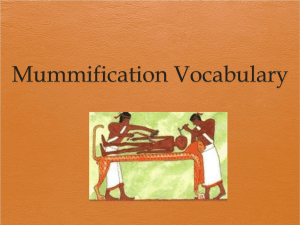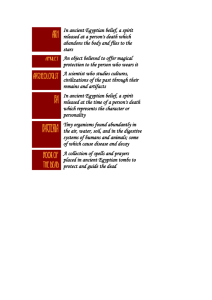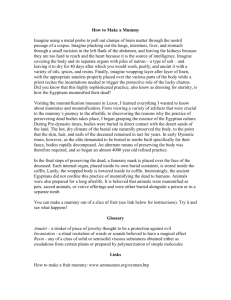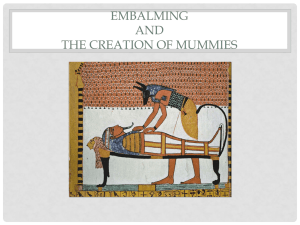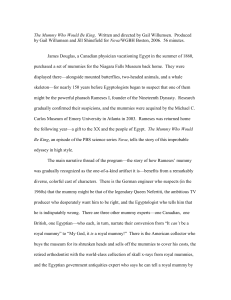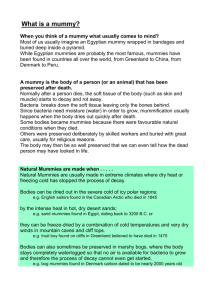Mummification
advertisement
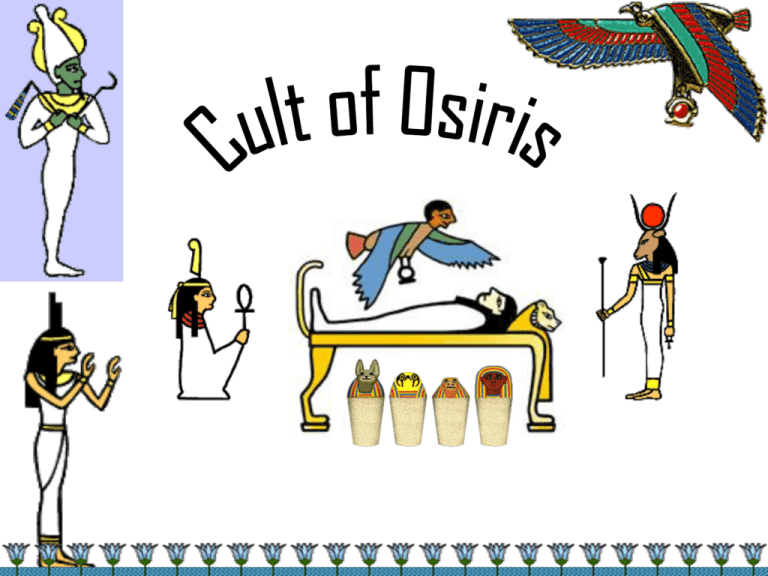
Mummies To live forever, it was absolutely necessary to prevent the dead body from decaying, since the parts of the soul still had a need for it. Three of the more well-known forms of the spirit were the ba, the ka, and the akh. It was believed that the ramheaded creator god Khnum sculpted babies and all the parts of their souls from clay. The ba was the personality. It was shown as a bird with a human head- in particular, the head of the person to which it belonged. The ka was the life force, like our modern definition of a soul, and it looked exactly like its person. Sometimes a statue modeled after the deceased would be placed in the tomb with the mummy. These "ka statues" were something of an emergency back-up, to make sure the ka had a substitute body to belong to in case something should happen to the mummy. In addition to a recognizable body, the ka also needed food to survive. When Egyptians left food and water at the tomb, they were leaving it for the ka. The akh was represented by a type of bird called a crested ibis. At death, the akh flew to the stars to spend eternity in the heavens. Oldest Mummy • 'Ginger' is believed to be the earliest known ancient Egyptian "mummified" body, being Late Predynastic and dating to approximately 3300 BC. The body, which lies in a fetal position and is nicknamed 'Ginger' because of its red hair, is not internationally renowned despite being older than other more famous mummies, such as those of Rameses II or Seti I. Mummification – Step 1 • Purification of the body • Ceremonial washing on the west bank of the Nile Mummification –Step 2 • A priest dressed in the jackal head costume representing Annubis chants over the body before the rippers remove the internal organs • The organs would be saved in canopic jars! The Sons of Horus • Baboon – Lungs Hapy • Jackal – Stomach Duamutef • Human – Liver Imsety • Falcon – Intestines Qebehsenuef • Heart: pickled and returned to the mummy The Brain • The Brain was removed with a knitting needle like hook inserted through the left nostril. • It was pulled out and discarded since the Egyptians felt the center of life was the Heart. Mummification tools: Brain hooks Oil jar Funnel (replica) Embalmer's knife (Royal Ontario Museum) Step 3 – Packing and Salting • After the removal of the internal organs, every drop of moisture was removed from the body. • The chest cavity was packed and the body covered in natron a natural salt. Natron: Sodium carbonate and Sodium bicarbonate • For forty days of the 70 day mummification process efforts were made to make sure all water was out of the body to prevent molds, fungus, and bacteria from growing. • After 40 days the body was ready for the final processing Plumping and Painting – Step 5 • The shriveled blackened corpse was plumped up like a pillow after a nights sleep. • The body was than covered with resin and painted. • Red ochre for Men • Yellow ochre for Women Wrapping – Step 6 • After being plumped and painted, the mummy was wrapped in the sacred linens of Osiris just as Isis had done. • As much as 3850 sq. feet of wrap was used. Wrapping took 15+ Days! • Beginning with the head the body was wrapped in layers. • Each layer was covered with resins to seal it. Portrait Mask – Step 7 • A red shroud is placed over the head and painted on it is a portrait of the dead person. • In the New Kingdom, finely detailed wax masks and beautiful sarcophaguses were used. Amulets of the New Kingdom • Gold sheathing might cover the toes as it did on King Tut. • Jewelry and Sacred amulets would be added at this time. • Teeth would reattached or added • Name tags would be place on the mummy Burial – Step 8 In the final step, the priest dressed as Annubis opens the mummies mouth. This awakens the senses and allows the soul to return to the body. • After the 70 Day preparation process, actual burial would take place. • A procession with professional mourners, food, family and priests went to the tomb. Journey of the Soul • The spirit of the person now journeyed through the underworld on its trip to judgment before Osiris. A long hook is used to smash the brain and pull it out through the nose. One of the embalmer's men makes a cut in the left side of the body and removes many of the internal organs. It is important to remove these because they are the first part of the body to decompose. The liver, lungs, stomach and intestines are washed and packed in natron which will dry them out. The heart is not taken out of the body because it is the centre of intelligence and feeling and the man will need it in the afterlife. The body is now covered and stuffed with natron which will dry it out. All of the fluids, and rags from the embalming process will be saved and buried along with the body. After forty days the body is washed again with water from the Nile. Then it is covered with oils to help the skin stay elastic. The dehydrated internal organs are wrapped in linen and returned to the body. The body is stuffed with dry materials such as sawdust, leaves and linen so that it looks lifelike. Finally the body is covered again with good-smelling oils. It is now ready to be wrapped in linen. Imsety the humanheaded god looks after the liver. Duamutef the jackal-headed god looks after the stomach. In the past, when the internal organs were removed from a body they were placed in hollow canopic jars. Over many years the embalming practices changed and embalmers began returning internal organs to bodies after the organs had been dried in natron. However, solid wood or stone canopic jars were still buried with the mummy to symbolically protect the internal organs. Hapy the baboonheaded god looks after the lungs. Qebehsenuef the falcon-headed god looks after the intestines. http://www.summum.org/mummification/ Entrance to an Egyptian Mestaba. Tomb painting illuminated by skylight within a Mestaba. Royal burial – Valley of the Kings Luxor, Egypt – Middle Kingdom. Egyptian Burial Jewelry – Middle & New Kingdoms of Egypt. Wooden sarcophaguses of the later New Kingdom and early Decline of Egypt. Child’s mummy and sarcophagus. Unwrapped head of a mummy. Note the layers of wrappings and the final RESINS that cover the layers of wrapping. Typical Egyptian bed. Nice pillow!! Sled, Rope, & Pyramid Block! Mummies of the World • Italy • Iceman, (Otzi) • 3300 BC Bog Bodies • The United Kingdom, the Republic of Ireland, Germany, the Netherlands, Sweden and Denmark have produced a number of bog bodies, mummies of people deposited in sphagnum bogs, apparently as a result of murder or ritual sacrifices. • The Haraldskær Woman is an Iron Age bog body. • Lindow Man, also known as Lindow II and Pete Marsh http://www.pbs.org/wgbh/nov a/bog/iron-nf.html South America • Some of the best-preserved mummies date from the Inca period in Peru and Chile some 500 years ago, where children were ritually sacrificed and placed on the summits of mountains in the Andes. • Ice Maiden, Momia Juanita Spanish for "Mummy Juanita" • between 12-14 years old, who died sometime between 1440 and 1450. Russia • The most famous undisturbed Pazyryk burial so far recovered is the "Ice Maiden" found by archaeologist Natalia Polosmak in 1993, a rare example of a single woman given a full ceremonial wooden chamber-tomb in the 5th century BC, accompanied by six horses. It had been buried over 2,400 years ago in a casket fashioned from the hollowed-out trunk of a larch tree. North America •Qilakitsoq is an archaeological site on the southwestern shore of the Nuussuaq Peninsula in western Greenland. Formally a settlement, it is famous for the discovery of eight mummified bodies in 1972. The bodies were found in an icy tomb and date to the 15th century AD. Ancient Egyptian pyramid Worker – age 2550 BC. Bribe paid to tomb worker to visit Field Museum’s Egyptian display!
